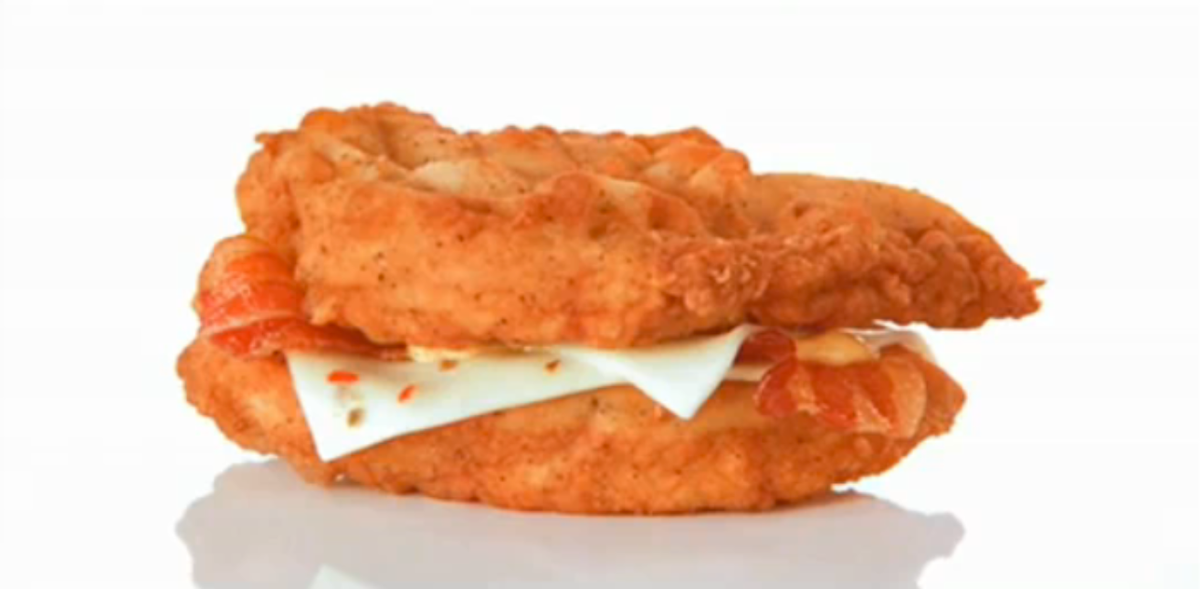At first glance, KFC's newest sandwich offering, the Double Down, sounds like a gag prop from a Mel Brooks movie: It is a sandwich made almost entirely of meat -- two pieces of bacon and cheese sandwiched between two cuts of chicken. The company's Web site (which includes an ominous countdown to the Double Down's Monday launch) helpfully explains that the sandwich "is so meaty, there’s no room for a bun!" Or as the manly men in the KFC commercial put it, "So long, bun!"
Given America's current obsession with fighting obesity, it seems like a strange time to be premiering an all-meat sandwich with 32 grams of fat, and so far most of those covering it have been somewhat, err, baffled. The A.V. Club's Nathan Rabin taste-tested the sandwich earlier this week with disastrous results ("each bite became a grueling endurance test ... the sandwich grew more revolting-looking with each bite"), and the folks at Eater have called it "the harbinger of the breadless apocalypse."
To find out what KFC was thinking when it developed the Double Down we called Darren Tristano, executive vice president at Technomic, a food industry consulting firm.
Why, in God's name, would KFC create something like the Double Down?
There are a few reasons: It's unique, it's shocking, it will appeal to younger generations, and people will talk about. But it's also a product they can create without adding new elements to their restaurants -- it can exist within the existing kitchen.
Who does KFC expect to buy this sandwich?
This isn't going to be a kids meal. This would be too much food for a child younger than 11 years of age -- this is for teenagers and older. They're targeting working-class consumers that have less discretionary income and are looking for a very satisfying meal. It's not necessarily about taste, but about quantity. The Double Down is a lot of food packed into a sandwich. Timing-wise, this is the start of the lawn-care season. We're starting to see spring cleanups and more high-energy outdoor activities -- so this could be fuel for that labor effort.
Isn't this a stunt product?
I think it's fair to say it is, but whether we like it or not, this product will appeal to a significant portion of the consumer base. Just think of "Jamie Oliver's Food Revolution" -- kids these days can recognize a McNugget but not a tomato.
There's been a lot of talk lately about the splintering of food tastes. What kind of consumer does KFC generally go after?
Demographically, KFC is above a Church's Chicken, maybe slightly above a Popeyes, and slightly below Chick-fil-A. It's definitely a blue-collar, lower-income audience. There are enough fast food outlets with broad demographic appeal that it's not unlikely you'll see a higher-end person looking for a lower-end product. Those people who are eating at Morton's Steakhouse are also still eating at McDonald's. We are all hiding our packages of chips in our cabinets.
Given the growing concern about obesity, isn't KFC risking a backlash by promoting this kind of product?
I don't think so. The sodium and fat content for the Double Down is pretty high, but the calorie content is reasonable. I think the important role of an operator is to provide healthier alternatives. Regardless of what you do, consumers are going to make their choice. This product has broad appeal -- I don't think it's going to damage their business or their image.
Most of the advance press about the sandwich has been about how disgusting it looks. Isn't that going to hurt KFC?
From a marketing standpoint it appears to be achieving the goal they had set, which is to get people interested in the product and get them to try it. Freak shows are disgusting but everyone seems to want to go to them anyways. When there's an accident on the highway everyone gapes. And, I'm sorry, but I'm really curious about it, and I'm probably going to try one next week.

Shares